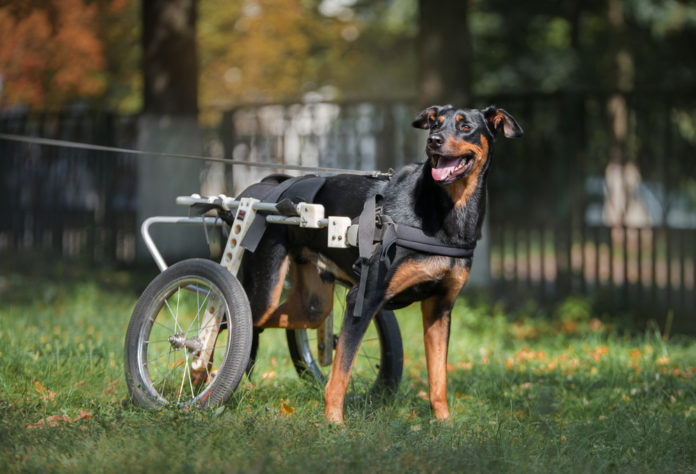Choosing a wheelchair for a dog with mobility issues

If your dog has mobility issues, the right wheelchair can make a huge difference to his quality of life.
One of the joys of sharing your life with a dog is going for walks together. But mobility problems caused by aging, injury or disease can make even a simple trip across the room painful or even impossible for some dogs. In the past, a loss of mobility usually meant the end, but thanks to canine wheelchairs and mobility carts, specially designed and fitted to suit each dog’s body type, capabilities, and limitations, even animals that are partially paralyzed can get moving again and enjoy good quality of life.
Different wheelchairs for different needs
Dog wheelchairs are not created equal, and that’s a good thing. Some dogs need assistance only for their rear legs, while others need help taking the load off of all four limbs. The latter often proves true for dogs who struggle with osteoarthritis, especially if obesity increases the burden on their weight-bearing joints. Fortunately, you can choose between both rear-support and full-support wheelchair options.
- A typical rear-support dog wheelchair features a pair of wheels attached to metal struts and rails. In addition to straps that anchor the wheels to the dog’s back legs, another support harness behind the dog’s front legs is attached to a pair of connecting horizontal rails. This arrangement provides gentle, much-needed support for weakened or painful rear legs.
- A full-support wheelchair bears a strong resemblance to a rear-support wheelchair except that it includes an additional, smaller pair of wheels near the dog’s front legs, as well as a sling to support the his midsection.
Selecting a size
The size and weight of your dog will obviously affect the size of the wheelchair you rent or buy for him. Companies such as K9 Carts provide helpful tips and measurement guides. They also make multiple sizes of wheelchairs with built-in adjustability, allowing you to fine-tune its fit for your own dog’s unique dimensions.
Other tips to enhance your dog’s wheelchair experience
Little things can mean a lot in the world of canine wheelchairs, including weight and strength, and the wheels themselves:
- The lighter the wheelchair, the better for dogs who struggle to get around.
- You also need to know that the design, material, and construction will be durable enough for safe, secure, long-term use. Aircraft-grade aluminum offers the ideal combination of these two attributes.
-

Cheaper foam wheels aren’t likely to hold up well over rough terrain or lots of walks. Overly-hard or rigid wheels may prove sturdier, but they can make for a rough ride. Tough, air-filled wheels can provide reliable service while also giving your dog that extra degree of shock absorption to help him over those inevitable bumps in the road.
The getting-acquainted process
Your dog will need to get familiar with his new wheelchair before you simply strap him in and take him for a walk. Remember that he has no idea what this strange thing is, much less understand that it’s supposed to be strapped onto him. Take your time during this getting-acquainted process.
In fact, don’t even strap your dog into the wheelchair at first; simply leave it near his bed and let him accept it as a harmless, normal household item. Once he seems to have done so, you can try placing him in the harness and letting him get the feel of the wheelchair.
With that accomplished, see if you can get your dog to make short trips within the home by playing with him or tempting him with treats. If he seems to get around smoothly in his wheelchair, you’re ready to start taking him on walks. Your dog will love his new freedom — and you’ll love watching him enjoy it!

Where to find dog wheelchairs
K9 Carts, k9carts.com
My Pets Brace, mypetsbrace.com
Walkin’ Wheels, handicappedpets.com



